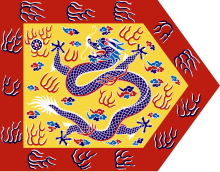
Back Bannière jaune à bordure French Panji Kuning Sempadan ID 양황기 Korean Манжийн Хөвөөт шар хошуу Mongolian Estandarte Amarelo Bordado Portuguese Жёлтое знамя с каймой Russian กองธงเหลืองขลิบ Thai Жовтий прапор із облямівкою Ukrainian Tương Hoàng kỳ Vietnamese 镶黄旗 Chinese
| Bordered Yellow Banner | |
|---|---|
 Flag of the Bordered Yellow Banner | |
| Active | 1615 – 1912 |
| Country | Later Jin |
| Type | Cavalry Musketeers |
| Part of | Eight Banners |
| Commander | the Emperor |
| Bordered Yellow Banner | |||||||
|---|---|---|---|---|---|---|---|
| Chinese name | |||||||
| Traditional Chinese | 鑲黃旗 | ||||||
| Simplified Chinese | 镶黄旗 | ||||||
| |||||||
| Mongolian name | |||||||
| Mongolian Cyrillic | Хөвөөт Шар Хошуу | ||||||
| Manchu name | |||||||
| Manchu script | ᡴᡠᠪᡠᡥᡝ ᠰᡠᠸᠠᠶᠠᠨ ᡤᡡᠰᠠ | ||||||
| Romanization | kubuhe suwayan gūsa | ||||||
The Bordered Yellow Banner (Chinese: 鑲黃旗) was one of the Eight Banners of Manchu military and society during the Later Jin and Qing dynasty of China. The Bordered Yellow Banner was one of three "upper" banner armies under the direct command of the emperor himself, and one of the four "left wing" banners.[1] The Plain Yellow Banner and the Bordered Yellow Banner were split from each other in 1615, when the troops of the original four banner armies (Yellow, Blue, Red, and White) were divided into eight by adding a bordered variant to each banner's design.[2] The yellow banners were originally commanded personally by Nurhaci. After Nurhaci's death, his son Hong Taiji became khan, and took control of both yellow banners. Later, the Shunzhi Emperor took over the Plain White Banner after the death of his regent, Dorgon, to whom it previously belonged. From that point forward, the emperor directly controlled three "upper" banners (Plain Yellow, Bordered Yellow, and Plain White), as opposed to the other five "lower" banners.[3][4] Because of the direct control of the three upper banners, there was no appointed banner commanders as opposed to the other five. The emperor's personal guards and guards of Forbidden City were also only selected from the upper three banners.[5]
- ^ Elliott 2001, p. 79.
- ^ Elliott 2001, p. 59.
- ^ Wakeman 1985, p. 158.
- ^ Elliott 2001, pp. 404–405.
- ^ 清史稿